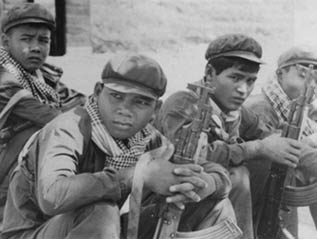Which Way the Trolley: America’s Hot Wars During the Cold War, Part 2
He returned to Cambodia in 1953 and quickly made contact with a Communist Viet Ming group operating on the edge of the Cambodian Vietnamese border. He organized a small guerilla group and began to train and organize his force. In the first years of the fight against the Royal government of Cambodia the Viet Ming did most of the fighting, but in time, his forces, the Khmer Rouge, eventually became more formidable and took over parts of Cambodia.
From the very beginning, Pol Pot’s regime was especially brutal. Captives were set to work as slave labor in remote rubber plantations and its product sold to finance his movement. Tribal minorities were treated very badly. Their dress and customs were suppressed and all were forced to conform to normative Cambodian ways, including the new Cambodian Communist dress that was 1930’s “Stalin chic,” workers cap required. Actually, even traditional Cambodian dress and cultural expressions such as religious dance were suppressed. Any opposition led to extermination.[18]

Child soldiers forced to fight for the Khmer Rouge.
During the early years of the insurgency, Pol Pot received an illumination that the real Marxist “proletariat” were the peasant farmers, not the city workers as Marx had believed. His ideal became to create a new society of peasants who would then repopulate the cities with the virtues of true communism.
As the Khmer Rouge took control of towns and cities these were emptied and the population was sent out to the country side. The poor and uneducated sent to collective farms to learn to be good Communists. But anyone with an education or profession was dispatched to extermination camps where they were tortured and worked to death. The Western press got a glimpse of this when the capital of Cambodia fell to the Khmer Rouge in 1975. I recall news footage of soldiers driving the people away for the city, including one patient still in a hospital bed – he would not have survived long.
The details of the horror and torture regime were never photographed or publicized while they happened – that is par for Communist regimes. A few news items did appear early on, as in the wholesale massacre of all Royal Cambodian Army officers on the day that Phenom Penh fell. I recall one of the prominent anti-war activists being interviewed on TV at this time. She claimed that the massacre happened because the Khmer Rouge had “learned violence from the American troops.” A more historically ignorant, false and ideologically-driven statement would be hard to match. For her, it avoided thinking of the possibility of the anti-war movement as having any negative consequences. Only years later did the full story emerge from accounts of survivors. Instead of vivid pictures, there were only some drawings they made of the horrendous times, and a few pictures of skull heaps. No one is sure how many Cambodians were massacred. Unlike the Nazis who kept meticulous records, the Khmer Rouge just slaughtered without recording numbers. Estimates of the genocide range from one to three million persons, many died by torture.

Genocide, torture, extermination.
The genocidal regime mercifully came to an end relatively quickly. Ironically, it was by the hand of its Communist neighbor, the united Vietnam. Pol Pak harbored suspicions that the Vietnamese wanted to incorporate Cambodia into a sort of Vietnamese empire, and insanely provoked a war with the Vietnamese. The Vietnamese Army quickly defeated the Khmer Rouge, driving its remnants into the jungle and liberated the country to a saner (less demonic) form of communism under their temporary administration.
Pol Pot continued the fight a limited guerilla war, and the Vietnamese decided not to fight that battle, and called for arbitration. Under the auspices of the United Nations, the exiled Prince of Cambodia returned, and a democratically elected government was installed. This was a surprising turn of events in the midst of Communist neighbors. Cambodia today is limping back to recovery, and the leaders of the Pol Pot regime were captured, tried and imprisoned. Pol Pot himself died in prison, possibly by suicide. In any case, he never expressed remorse or thought anything he did was wrong.
Reflections, Which way the trolley?
It is now sixty years since the Korean War, forty years since the fall of Saigon and going on twenty-eight years since the fall of the Berlin wall. It is possible for some review and reflection on the Cold War.
First: We should note that Stalinism and Maoism were at the brink of an explosive expansion at the end of World War II. Europe was exhausted and devastated by war. Communist parties in France, Greece, Italy and elsewhere were resurgent. A much larger expansion of Communism might well have taken place in the late 1940s and early 1950s than its spread into Eastern Europe and China.
For example, Henry Wallace was Franklin Roosevelt’s very Left-leaning vice president during 1941-1945. Had he not been removed from the ticket in the 1944 Democratic convention and replaced by Harry Truman, major disasters might have resulted. Wallace was a Stalinist apologist and held pro-Soviet views, and the Cold War might not have begun at all. Instead, Stalin’s agents and allies might well have taken all of Europe in the same manner as Czechoslovakia was snatched into the Soviet orbit without a single shot fired. Without Truman’s encouragement and the support of Truman’s anti-Communist secretary of State, Dean Aitcheson, the European center and right parties would have had little support or strength to resist Communist takeovers. Certainly France would have had no support, moral or material, for their war in Indochina.
Category: Church History, Winter 2017


